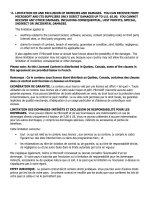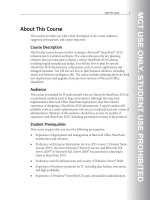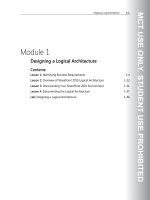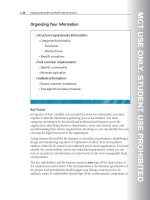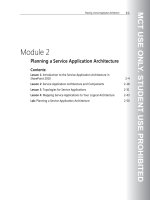Designing a Microsoft SharePoint 2010 Infrastructure Vol 1 part 20 ppsx
Bạn đang xem bản rút gọn của tài liệu. Xem và tải ngay bản đầy đủ của tài liệu tại đây (693.8 KB, 10 trang )
MCT USE ONLY. STUDENT USE PROHIBITED
Planning for Performance and Capacity 3-57
Database
Size
guideline
Read/write
characteristics
Description
State 1 GB–1
terabyte
Variable This database stores temporary state
information for InfoPath Forms
Service instances, the chart Web Part,
and Visio Service instances.
Note: The read/write characteristics of the database should influence your decision
about storage in areas such as RAID configuration. Different physical disk types and
different RAID configurations can provide different read and write performance. For
example, RAID 5 typically has poor write performance when compared with RAID 1.
Question: Which RAID type is typically recommended for transaction log storage
of SQL Server databases?
Additional Reading
For more information about database types and descriptions in SharePoint 2010,
see
MCT USE ONLY. STUDENT USE PROHIBITED
3-58 Designing a Microsoft® SharePoint® 2010 Infrastructure
Designing Capacity for Content Databases
Key Points
The following process describes how to estimate the storage that you require for
content databases, without considering log files:
1. Calculate the expected number of documents. D represents this value in the
formula at the end of this list.
2. Estimate the average size of the documents that you will be storing. S
represents this value in the formula at the end of this list.
3. Estimate the number of list items in the environment. L represents this value
in the formula at the end of this list. List items can be more difficult to estimate
than documents, particularly if there is no existing SharePoint 2010
implementation to base this on. As a general guideline, estimate three times
the number of documents.
4. Determine the approximate number of versions. Estimate the average number
of versions that any document in a library will have. V represents this value in
the formula at the end of this list. The value of V must be at least 1 (for a
single, current version).
MCT USE ONLY. STUDENT USE PROHIBITED
Planning for Performance and Capacity 3-59
5. Use the following formula to estimate the size of your content databases:
Database size = ((D × V) × S) + (10 KB × (L + (V × D)))
The value of 10 KB in the formula is a rough estimate of the amount of metadata
that SharePoint Server 2010 requires. You should give and calculate all size values
in KB to ensure consistency in the calculations.
Note: The features that you are using will determine how you calculate the number of
documents. If you are migrating from a current system, it may be easier to extrapolate
your current growth rate and usage. If you are creating a new system, review your
existing file shares or other repositories and estimate based on that usage rate.
Additional Reading
For more information about storage and SQL Server capacity planning and
configuration in SharePoint 2010, see
MCT USE ONLY. STUDENT USE PROHIBITED
3-60 Designing a Microsoft® SharePoint® 2010 Infrastructure
Designing Capacity for Search Databases and Index
Partitions
Key Points
The implementation of search in a SharePoint farm can have significant impact on
storage requirements. When a server that hosts the crawl role performs a crawl on
content, the following events occur:
• Search entries are created or updated in an index partition, which is held on
crawl and query servers.
• Metadata about crawled items is added to the Search Service property
database.
• The Search Service crawl database is updated with information about the crawl
state.
In addition, the search administration database stores crawl rules. Based on the
corpus size, crawl and index entries can require significant storage.
The following table describes the three databases that are associated with the
Search Service application, with size and read/write characteristics.
MCT USE ONLY. STUDENT USE PROHIBITED
Planning for Performance and Capacity 3-61
Database
Size
guideline
Read/write
characteristics
Description
Search Service
administration
database
1 GB–100
GB
Approximately
equal
This database hosts the Search
Service application configuration,
the access control list (ACL), and best
bets for the crawl component. Every
user and administrative action
requires access to this database.
Search Service
crawl database
1 GB–1
terabyte
Read-heavy
(ratio 3:1)
This database stores the state of the
crawled data and the crawl history.
Search Service
property database
1 GB–1
terabyte
Write-heavy
(ratio 1:2)
This database stores information that
is associated with the crawled data,
including properties, history, and
crawl queues.
Index Partitions
You must also plan for index partition storage on the query servers. Index
partitions hold a part of the content index (or the entire content index) against
which SharePoint 2010 runs queries to provide search results. You can distribute
the index partitions to improve performance. The size of the index and index
partitions are determined by the size of the crawled corpus, and they range from 1
GB to 1 terabyte. For general sizing guidelines:
• The index may occupy 5 to 10 percent of the crawled corpus size.
• The crawl databases may occupy approximately 5 percent of the crawled
corpus size.
• The property databases may occupy approximately 1.5 percent of the crawled
corpus size.
Note: The index and search database sizes can vary greatly depending on the type of
files that are crawled and the file crawl limit.
Note: The index servers build small parts of the index before forwarding these parts to
the query servers. The index servers require a small amount of local storage for this
process.
MCT USE ONLY. STUDENT USE PROHIBITED
3-62 Designing a Microsoft® SharePoint® 2010 Infrastructure
Additional Reading
For more information about database types and descriptions in SharePoint 2010,
see
For more information about storage and SQL Server capacity planning and
configuration, see
MCT USE ONLY. STUDENT USE PROHIBITED
Planning for Performance and Capacity 3-63
Planning for Remote BLOB Storage for SharePoint 2010
Key Points
BLOBs are data elements that have either of the following characteristics:
• Unstructured data with no schema (such as a piece of encrypted data).
• A large amount of binary data (many megabytes or gigabytes) that has a very
simple schema, such as image files, documents, streaming video, or sound
clips.
By default, SharePoint 2010 stores BLOBs in the content databases. This can result
in a dramatic size increase for the content database and associated storage
requirements.
SharePoint 2010 with SQL Server 2008 R2 supports remote BLOB storage. With a
remote BLOB storage provider, remote BLOB storage can store BLOB data outside
the content database on separate storage.
The SQL Server 2008 R2 Feature Pack includes a RBS FILESTREAM provider
called the local FILESTREAM provider. This provider is able to store BLOBs on
separate, local disks.
MCT USE ONLY. STUDENT USE PROHIBITED
3-64 Designing a Microsoft® SharePoint® 2010 Infrastructure
SQL Server 2008 Enterprise and SQL Server 2008 R2 Enterprise also offer remote
BLOB storage without FILESTREAM that can use NAS or DAS storage, and
additional third-party remote BLOB storage options may be available.
Note: It is important to identify that SharePoint 2010 (rather than SQL Server 2008)
supports the use of the remote BLOB storage provider that you want to use.
Additional Reading
For more information about planning for remote BLOB storage in SharePoint
Server 2010, see
MCT USE ONLY. STUDENT USE PROHIBITED
Planning for Performance and Capacity 3-65
Lab: Planning for Performance and Capacity
Exercise 1: Creating a Performance Plan
Scenario
Having completed the logical architecture planning and service application
planning activities, you must now identify the number of WFE servers that are
required for the Contoso, Ltd. SharePoint 2010 production farm.
There is additional planning information available in the supplied documents. Use
these documents to produce your performance plan.
The main tasks for this exercise are as follows:
1. Read the supporting information.
2. Complete the Performance worksheet in the Performance and Capacity
Planning Worksheet.xlsx file.
MCT USE ONLY. STUDENT USE PROHIBITED
3-66 Designing a Microsoft® SharePoint® 2010 Infrastructure
f Task 1: Read the supporting information
1. Read the lab scenario.
2. Log on to 10231A-NYC-DC1-03 as CONTOSO\Ed with the password
Pa$$w0rd.
3. In the E:\Labfiles\Lab03\Starter folder, read the Performance and Capacity
Requirements.docx file.
4. In the E:\Labfiles\Lab03\Starter folder, read the SharePoint 2010 Capacity
Planning Excerpt.docx file.
5. In the E:\Labfiles\Lab03\Starter folder, read the information under Workload
in the Right-Sizing SharePoint Server 2010 Deployments section of the
SPServer2010CapacitySizingOverview.docx file.
f Task 2: Complete the Performance worksheet in the Performance and
Capacity Planning Worksheet.xlsx file
• In the E:\Labfiles\Lab03\Starter\Performance and Capacity Planning
Worksheet.xlsx file, complete the details on the Performance worksheet to
establish the number of WFE servers that you require.
Exercise 2: Creating a Capacity Plan
Scenario
You now need to plan the storage requirements for Contoso, Ltd. There is
additional planning information available in the supplied documents. Use these
documents to produce your capacity plan.
The main tasks for this exercise are as follows:
1. Read the supporting information.
2. Complete the Capacity worksheet in the Performance and Capacity Planning
Worksheet.xlsx file.
f Task 1: Read the supporting information
1. Review the lab scenario.


